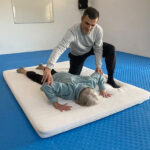People who “hate cardio” are either doing it wrong or don’t understand it. If you hate cardio, I get it. In fact, I’ve lived it. I was like you for years.
WORDS Bob Aerohfit
For many of us, cardio feels like work. It’s a joyless obligation, like eating plain oatmeal. If we do it, it’s because we think it’s good for us – not because we actually want to. The typical reasons you’ll hear people say they don’t do cardio are:
“It sucks” – it’s too hard and feels awful.
“It’s boring” – you do the same thing over and over for a long time. Ugh.
“It’s not effective” – I tried running once and I still have love handles. #FAIL
But those thoughts are misguided. The real reason we hate cardio is that we’ve failed to be creative. Or because we’re behind the times. Or we misunderstand what cardio really is.
There is a popular misconception that “cardio” means “slogging away on an elliptical for 20 minutes or more”. But I advocate that any movement can be made into cardio with proper programming.

Why do I say “behind the times”? Because recent technology makes proper cardio training easier and more accessible than ever. Your smartphone plus a heart rate monitor can open up a whole new universe of smarter, more effective training.
The reason people “misunderstand” cardio really is because they confuse cardio with its far less interesting cousin, aerobics.
If these errors lead us to avoid doing or programming cardio, that is a problem. Because the benefits of true cardio training are vast. As trainers, we ought to be concerned with more than just how someone looks or their bench max. Our job is to help build fitter, healthier, longer-living human beings. Done well, cardio helps a person make progress on all of those fronts – and build a more muscular, better-looking physique in the process.
While cardiovascular exercise can be considered a form of aerobic exercise, the terms are not synonymous. Aerobics encompasses any form of movement sustained long enough that the body needs to utilise oxygen to fulfil its energy demands. Therefore, everyday tasks such as walking can be considered aerobic if they’re sustained long enough.

Cardiovascular exercise, on the other hand, needs to improve the capacity of the cardiovascular system. In other words, we’re focusing on the capacity of the heart. This means true cardio requires three things:
- We need to monitor the heart rate.
- Exercise must elevate the heart rate to a target level.
- Heart rate must stay within the target range for an intended period of time.
Working within those target levels or zones strengthens the heart. It also improves circulation and allows a person to improve the capacity of their cardiovascular system.
Many professionals spend enough of their working lives in Microsoft Excel, so they don’t need yet another set of numbers to pay attention to. But implementing a heart rate monitor, and using it effectively, can be a paradigm shifter for you.
I’ve experienced this firsthand, both in my own workouts and in training clients. Turns out that what we all were doing, when we thought we were doing cardio, mostly fell into one of two categories:
Too much – workouts were suffer-fests as a result.
Not enough – workouts felt boring because they were, in fact, under-challenging.
Training with a heart rate monitor surprised me in how much it changed what cardiovascular exercise meant. Cardio became much more enjoyable –and effective. Over time, it helped improve work capacity and strength while shrinking the recovery time needed.
I’m still not a big fan of cardio, but I am enjoying the process!
Top Tip: By using a heart rate monitor, you produce better results with less pain.
Instagram: Bob Aerohfit
00491783379591













